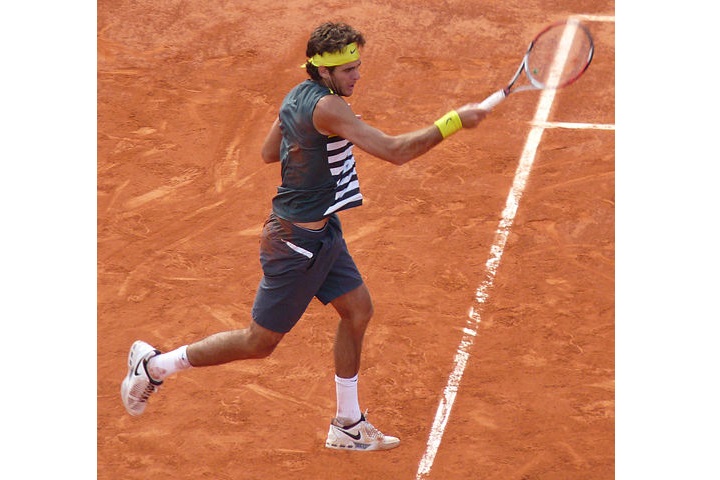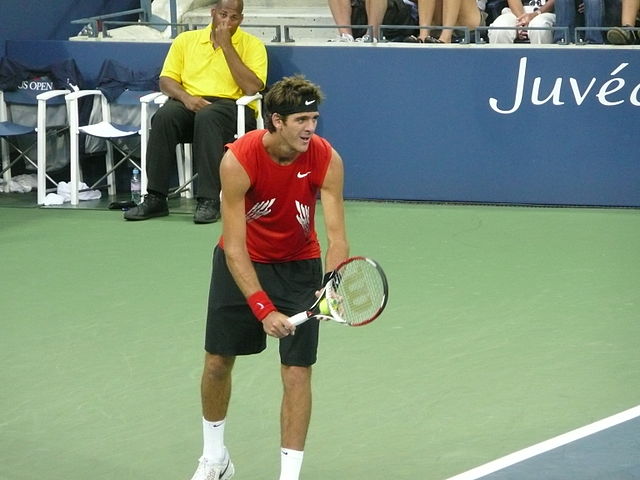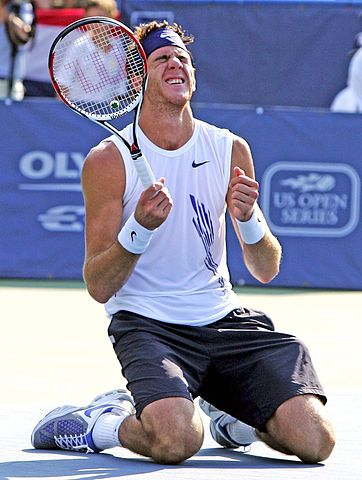
In 2022, I’m counting down the 128 best players of the last century. With luck, we’ll get to #1 in December. Enjoy!
* * *
Juan Martín del Potro [ARG]Born: 23 September 1988
Career: 2006-19
Plays: Right-handed (two-handed backhand)
Peak rank: 3 (2018)
Peak Elo rating: 2,233 (3rd place, 2009)
Major singles titles: 1
Total singles titles: 22
* * *
Since February 2, 2004, when Roger Federer took over the number one ranking, the top player on the ATP computer (whether it be Fed or someone else) has won 1,165 matches against 174 losses, a win percentage of 83%. If you take out the 100-plus matches that the Big Four played against each other when one of them was number one, the top player won more than 90% of their 1,200 matches.
In this span of nearly two decades, only a dozen players have won at least four times against the world number one:
Player Matches Wins Win% Rafael Nadal 41 22 53.7% Novak Djokovic 31 14 45.2% Andy Murray 41 12 29.3% Juan Martín del Potro 24 10 41.7% Roger Federer 25 8 32.0% Dominic Thiem 13 5 38.5% Stan Wawrinka 26 5 19.2% Alexander Zverev 11 4 36.4% Nikolay Davydenko 19 4 21.1% Tomas Berdych 34 4 11.8% David Ferrer 26 4 15.4% Daniil Medvedev 8 4 50.0%
Juan Martín del Potro is the only man outside of the Big Four to reach double digits. In fairness, two of those wins were by retirement, when Novak Djokovic quit in a 2011 Davis Cup match and Rafael Nadal surrendered at the 2018 US Open after losing two sets. Even discounting that pair of results, he snatched as many matches from number ones as Federer did, and he won at a better clip than Andy Murray’s.
And–oh yeah–these aren’t exactly cheap victories. The list includes the 2009 US Open final, when Delpo handed Federer his first defeat in Flushing for six years. He knocked out the number-one ranked Federer in two other title matches, one in the enemy territory of Basel, the other recovering from match point down to win at Indian Wells in 2018. Del Potro also scored another upset for the ages: his first-round shock of Novak Djokovic at the 2016 Olympics.
Even Delpo’s catalog of losses to number ones is impressive. He pushed both Djokovic and Nadal to five sets at Wimbledon, and when the All-England Club hosted the Olympics in 2012, del Potro went toe to toe with Federer for four and a half hours. The final score, 3-6, 7-6(5), 19-17, went in Fed’s favor, but it set a pile of records and ultimately led to a rule change that will stop Olympic matches from ever again taking so long.
You don’t have to listen to tennis commentary for long before you hear about a guy who, on a good day, can beat anybody. Often, it’s just wishful thinking that a one-sided match will turn out to be more suspenseful than expected. With del Potro, it was absolutely true. He had the weapons, the stamina, and the mental strength to beat anybody–and on the sport’s biggest stages, he did exactly that.
* * *
I first saw Juan Martín del Potro play at the US Open in the 2006 qualifying rounds. If you spend enough time watching challenger and qualifying-level tennis, you’ll spot the occasional megastar before he makes his breakthrough. Then you can spend the next few decades telling everyone you meet about it.
Hipster brags of “I saw him when” may be boring, but del Potro never was. A month short of his 18th birthday, his serve was still mostly punchless, relying on spin and the angles he could generate from his height of six-foot-six. His on-court demeanor was laconic, verging on sleepy. But even at that stage, the effortless power was there. The man who would become known as the Tower of Tandil–after his hometown in Argentina–had plenty of weapons. His forehand was already devastating.

Delpo’s final-round qualifying opponent was the Austrian Daniel Köllerer, a mind-bogglingly inconsistent shotmaker with a temper that made John McEnroe look like Mr. Rogers. (Köllerer would be banned from pro tennis in 2011 for match-fixing. Evidence was easy to come by because everyone else on the circuit hated him so much.) “Crazy Dani” was a tricky opponent who had beaten del Potro at a Challenger ten months earlier, and they would meet against in the third round of the Open in 2009. The 17-year-old Argentine simply sat back and watched Köllerer implode. The score was 6-3, 6-2, and Delpo would never play grand slam qualifying again.
He made steady progress throughout 2007, climbing into the top 50 and ending the year as the highest-ranked teen. There were some encouraging results–a win over top-tenner Tommy Robredo in Madrid; a five-set loss to Fernando González in Australia–but he struggled to stay fit. He retired from five matches (including the near-miss against Gonzalez), and he wouldn’t be fully fit again until midway through 2008.
Delpo responded by replacing both his coach and his physio. The new man in his corner, Franco Davín, gave him a burst of confidence, and the pair would stay together for seven years. After an early exit at Wimbledon to Stan Wawrinka, del Potro put the tennis world on notice. He won his first tour-level title in Stuttgart … then another … and another … and another. All told, he won 23 straight matches, including four titles, with wins over Richard Gasquet, Mardy Fish, Andy Roddick, Tommy Haas, and Kei Nishikori.
It took an in-form Andy Murray to stop him in the US Open quarter-finals, and even that was a four-hour struggle in which Delpo hit 27 forehand winners past one of the best retrievers in the game. When Roddick lost to the youngster in Los Angeles that summer, he said that del Potro had the ability to hit hard in any direction–“a good thing for him, bad for the rest of us.” Another month, and the Argentine cracked the top ten, two weeks after his 20th birthday.
* * *
Del Potro finished 2008 ranked 9th in the world, the only player under the age of 21 inside the top 20. He was 16 months younger than Djokovic and Murray, and it was increasingly clear that if anyone was going to break the growing stranglehold of the Big Four, it was the quiet giant from South America.
For most of 2009, Delpo solidified his status as the next guy on the list, rising to 5th on the ATP computer in April. He also learned just how difficult it would be to go farther. He lost to Federer in Australia, Nadal at Indian Wells, and Murray in Miami. Djokovic knocked him out of Rome. Federer beat him again at both Madrid and Roland Garros, the latter in five sets. del Potro upset Nadal in the Montreal semis, then lost to Murray in the final.
The US Open figured to be more of the same. Federer had won the tournament five years running, and no one outside of Fed, Nadal, and Djokovic had won a major since the Australian in 2005. Del Potro was seeded sixth, and he made easy progress, losing only two sets in his first five matches. That earned him a semi-final date with Rafa. Delpo turned in the best performance of his career to date, hitting 35 winners to Nadal’s 20, and winning 6-2, 6-2, 6-2. When he was able to hit a forehand, he won the point a remarkable 59% of the time.
Waiting in the final–of course–was Roger Federer. The two men had faced off six times. Before the French Open, Delpo hadn’t won a set. In the Australian Open quarter-finals that year, Fed obliterated him, 6-3, 6-0, 6-0. When the world number one raced to a set-and-a-break lead in just 45 minutes, history seemed to be repeating itself.
Del Potro settled down and made a match out of it. Federer served for the second set at 5-4. At 30-30, Delpo rifled a forehand down the line on his second shot–winner. Break point, Fed came in, Delpo hit a forehand passing shot down the line–winner. Del Potro reached set point in the tiebreak on his own serve. Fed sliced a deep return to the backhand, the challenger ran around it to hit an inside-out forehand–winner.
When the forehand was firing, no one–not even the Swiss maestro–could touch it. Del Potro lost the third set when his serve deserted him late in the frame. But unlike almost everyone else who came close to beating Fed in those years, Delpo came back stronger. He broke the top seed to love at 2-all in the fourth, and Fed muscled the score back to even, the Argentine took a second tiebreak. In a set where he held Federer to a mere two forehand winners, Delpo hit eleven.
Del Potro hit two more forehand winners to break for a 2-0 advantage in the decider, and he never let go. When Federer had a game point to stay in the match at 2-5, Delpo delivered yet another forehand winner down the line. Two points later, yet another big forehand forced an error, and the match went to the Tower of Tandil. A star was born, and at age 20, the sky was the limit.
* * *
The 2009 US Open final was not del Potro’s last hurrah–far from it. I’ve already told you about his big upsets more than a half-decade later, and the small print up top reminds us that he finally climbed to number three in the rankings in 2018.
But Delpo would never again play a match as healthy as he did in 2009. Here’s the rest of his career in one graphic:
A right wrist injury sidelined him for almost the entire 2010 season, and despite leading Argentina to the Davis Cup final in 2011, he needed most of that campaign just to return to form. He was winning regularly again by 2012, only to discover that Federer hadn’t lost a step. The two players met eight times that season, and Fed won the first six, including the Australian quarters, the French quarters, and the heart-breaking marathon at the Olympics. Delpo beat Djokovic for the Olympic bronze, and he turned things around against Federer with wins in Basel and in London at the Tour Finals. It looked like another deep grand slam run was still in his future.
2013 was another collection of near-misses. A final at Indian Wells (three-set loss to Nadal), a partially-lost clay-court season due to a viral infection, and a semi-final at Wimbledon (five-set loss to Djokovic). He recorded wins over each of the Big Four–just not at the right time for another major championship–and returned to the top five.
And then it was the other wrist. Between the year-end finals in 2013 and the Rio Olympics in 2016, del Potro played only 35 matches.
* * *
Delpo had always been popular with fans. His electric game drew them in, and his soft-spoken good nature won them over. Players found him endearing, too. Some Federer supporters believe that Fed lost to him so often because their hero liked him too much. Del Potro’s post-match hugs were legendary. Jason Gay wrote in The Wall Street Journal, “If he was not your favorite player, he was your favorite player’s favorite player.”
Every successful return to the tour added to his allure. There was no way that a player could undergo so many surgeries, rehab both wrists, and still come back strong. Yet in some ways, the older, rebuilt Delpo was even better.
The left wrist injury made it harder for Delpo to hit two-handed backhands with power. He relied more on his less-effective slice, but more importantly, he shifted tactics to emphasize the monster forehand even more. When he faced Djokovic in the opening round at the 2016 Olympics, he walloped 32 forehand winners in just two sets. Barely halfway into another comeback, still ranked 141st in the world, Delpo rode his pared-down game to a Olympic semi-final win over Nadal. He pushed Murray to four sets in the final before settling for a silver medal.
Del Potro 3.0 wasn’t just about the power game–it relied on a heart as big as the man himself. As a kid, he dreamed of winning a grand slam and the Davis Cup. Argentina had never done the latter. Without a second star behind Delpo, it seemed unlikely that they would break the losing streak. He rejoined the team for the 2016 semi-finals, and barely a month after the Olympic defeat, he came back from a two-sets-to-one deficit to beat Murray.
In November, he helped his country finish the job. He beat Ivo Karlović in the second rubber, then lost in the doubles as Croatia took a two-to-one lead. With the Cup on the line, del Potro came back from another two-to-one disadvantage, this time against Marin Čilić. Federico Delbonis straight-setted Karlović, and the trophy went to Argentina.
In his career up to that point, del Potro had fallen behind two sets to one on 20 occasions. 16 times, he lost. The other four: the 2009 US Open final, a 2010 Australian Open match against James Blake, and those two critical matches of the 2016 Davis Cup.
* * *
In Buenos Aires this February, del Potro returned to the ring one last time. The tennis world tuned in to watch for flashes of the old Delpo magic, but he lost easily to Delbonis, 6-1, 6-3. It had been 965 days since his last tour-level match, so it was understandable that he’d need more time to get back in form.
Del Potro had entered a second event in Rio de Janeiro, but he withdrew. It wasn’t really a comeback–it was a farewell.
Usually when we talk about injury-riddled careers, we focus on the what-ifs. It’s certainly tempting to speculate about what Delpo could’ve accomplished with two healthy wrists. But in his case, it’s beside the point. He is a living legend to fans and an inspiration to his peers. In his limited time on court, del Potro delivered far more than one career’s worth of memorable moments, dramatic upsets, and just flat-out eye-popping tennis.
